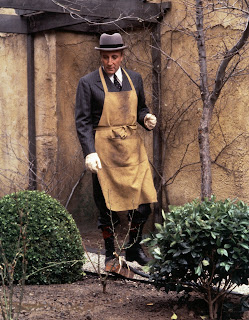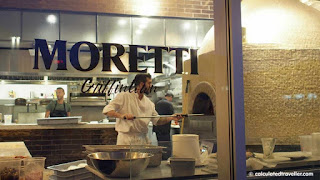accessibility, a smile, a figure. It is based on appearing as a person of importance.' ~ Jerzy Kosinski
I recently watched, again for the 12th time, 'Being There' (1979), thanks to a great and
favorite channel ... TCM (Turner Classic Movies). In a time of a buffoon as president I
realized the similarities between Chauncey Gardiner (Peter Sellers) and Donald J. Trump.
I read that following the upset in Alabama of Doug Jones to the U.S. Senate, The Fanta King
through a television set out of the window. Can you even imagine the absurdity of a President
of the United States, and not a banana republic, behaving in that manner, and so I thought
of Chauncey. He wasn't violent per se, but his life revolved around the television.
The question asked is not 'Is he a good man?' It's 'what circles does he move in?' 'Being
There' is a very funny and thought-provoking movie in the most subtle manner possible. It
can be seen as a fairy tale, a political story, and/or a religious parable on the nature
of identity in a media age. Director Hal Ashby's adaptation of Kosinski's 1971 novel is
a tour de force of sensitivity and well-realized pacing.
Chance (Peter Sellers), an individual of mysterious origins, is the gardener in the
Washington D.C. house of a wealthy and eccentric old man. His only pastime is watching
television, but when the owner dies, the lawyers for the estate force Chance to leave.
He finds himself out on the street with no birth certificate, driver's license, chequebook,
or medical records. And Chance can't read or write. Dressed in one of his employer's
custom-tailored suits, Chance looks like a successful businessman. At least that's what
Eve Rand (Shirley MacLaine), the wife of a rich and powerful industrialist, thinks when
her limousine bruises his leg. She offers to have a doctor check him at her home. When
he says, 'I am Chance, the gardener,' she hears, 'I am Chauncey Gardiner.' Her husband
Benjamin Rand (Melvyn Douglas, who won an Oscar), an old and ailing patriarch, takes an
immediate liking to the soft-spoken and self-confident visitor, and so Chance is asked
to stay with them during his recuperation.
While the President (Jack Warden) is in a meeting with Rand, he asks Chauncey's opinion
of the economy. 'In a garden, growth has its season... as long as the roots are not severed,
all will be well.' The Chief Executive uses the line in a speech and the press is soon
clamoring to know more about this new economic advisor. Invited to appear on TV, Chauncey
is an instant success. Although Rand's doctor, Robert Allenby (Richard Dysart) has his
doubts about the man, both the CIA and the FBI fail to come up with any information on
him. Chauncey wows a Russian diplomat at a reception on Capitol Hill and is eventually
seduced by Eve. In the end, Rand dies and passes on both his estate and his wife to
Chauncey. There is even talk among influential businessmen that Mr. Gardiner is
presidential material.
One of the hallmarks of a parable of this type is that it can serve as host to
a treasure trove of interpretations. Like the idea of Chance as the Jesus of the
electronic age, living by the TV Bible, speaking in botanical parables, and hailed as
a savior by the media-dominated society. Or how about seeing the old man as God, Chance
is Adam and TV as his mythology. The lawyers are the angels who send him out of the
garden. Eve takes Chance home to tempt him with the fruits of popularity and power. Or
see Chance as yourself experiencing all the ways in which others try to force you to
play a part in their movies. For my part I hail the political prophecy of 'Being There'
as individuals have been elevated to high political office for simply becoming popular
to viewers coming across well on television. Or here's a final one to process ... the film
is simply a very savvy meditation on being present — being at the right place at the
right time.
© Frank Borsellino™
© From Where I Sit™
writer/blogger/bon vivant
December 12, 2017





